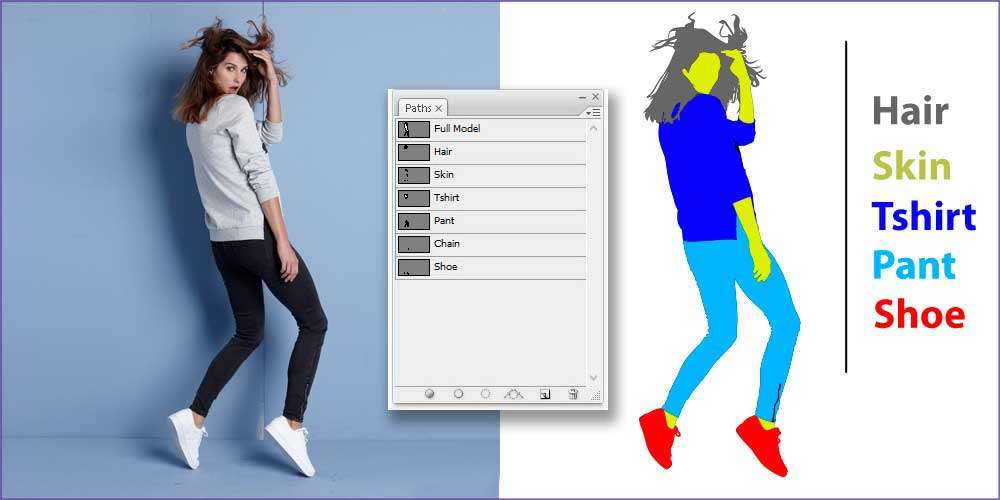A clipping path is a closed vector path, also known as a mask or silhouette, used in image editing software to separate an object from its background. A clipping path is important because it allows you to isolate an object from its background, making it easier to manipulate the object or place it in a new environment. Clipping Types mainly describe the type of object. Many software applications support the creation of clipping paths, including Adobe Photoshop, Adobe Illustrator, and CorelDRAW.
There are several types of clipping paths, including:
Basic or Simple Clipping Path:

A basic or simple clipping path is the most common type of clipping path used to isolate a single object with a basic shape. This type of clipping path is often used for images of products, such as a box or a watch, where the object has a simple shape with straight lines and smooth curves. To create a simple clipping path, the image editor uses a selection tool, such as the Pen tool in Adobe Photoshop, to trace around the edge of the object and create a closed vector path. This path can then be used to isolate the object from its background, making it easier to edit or place the object on a new background. A simple clipping path is relatively easy and quick to create, making it a cost-effective option for many businesses and designers.
Compound Clipping Path:

A compound clipping path is a type of clipping path used to isolate an object with a complex shape that includes multiple elements. This type of clipping path is commonly used in product photography, where the object being photographed has multiple components or details, such as a car with wheels, windows, and other features. To create a compound clipping path, the image editor will create multiple vector paths around each element of the object, then combine these paths into a single compound path. The compound path can then be used to isolate the entire object from its background. This process requires more time and skill than a simple clipping path, as it involves more precise selection and path creation. However, it allows for greater accuracy in isolating complex objects and producing high-quality images with professional-looking cut-out effects.
Multiple or Complex Clipping Paths:

Multiple or complex clipping paths are used to isolate several objects within an image, each with its own clipping path. This type of clipping path is commonly used in product photography or catalog design where several products are placed on a single background. In this case, each product will have its own clipping path created around it to isolate it from the background. The multiple paths can be saved in a single file or in separate files, depending on the requirements of the project.
Creating multiple or complex clipping paths can be time-consuming and requires a high level of skill and attention to detail. It is important to ensure that each path is accurate and that the edges of each object are smooth and natural-looking. The resulting images can have a professional and polished appearance, making them ideal for use in marketing materials, e-commerce websites, and other applications where high-quality product images are needed.
Transparent or Alpha Channel Masking
Transparent or alpha channel masking is a type of clipping path that is used to create transparency in an image, allowing the background to show through in certain areas. This technique is commonly used in product photography to create the illusion of a transparent object, such as a glass or plastic bottle, or to remove the background from an object to make it easier to place on a different background.
To create a transparent or alpha channel mask, the image editor will create a clipping path around the object, then use a layer mask or alpha channel to remove the background from the areas outside of the path. This process creates a transparency effect that allows the background to show through, making the object appear to be transparent or floating on a new background.
Creating a transparent or alpha channel mask requires skill and attention to detail, as it is important to ensure that the edges of the object are smooth and natural-looking. This technique is often used in e-commerce websites and advertising, as it can help to make product images more attractive and engaging to potential customers.
Clipping path is a technique used in image editing to isolate an object from its background. There are different types of clipping paths, including basic or simple clipping path, compound clipping path, multiple or complex clipping paths, and transparent or alpha channel masking. The type of clipping path used depends on the complexity of the object being isolated and the desired effect for the final image. Clipping paths require skill and attention to detail to ensure accurate and natural-looking results. They are commonly used in product photography, e-commerce websites, marketing materials, and other applications where high-quality images are needed.

